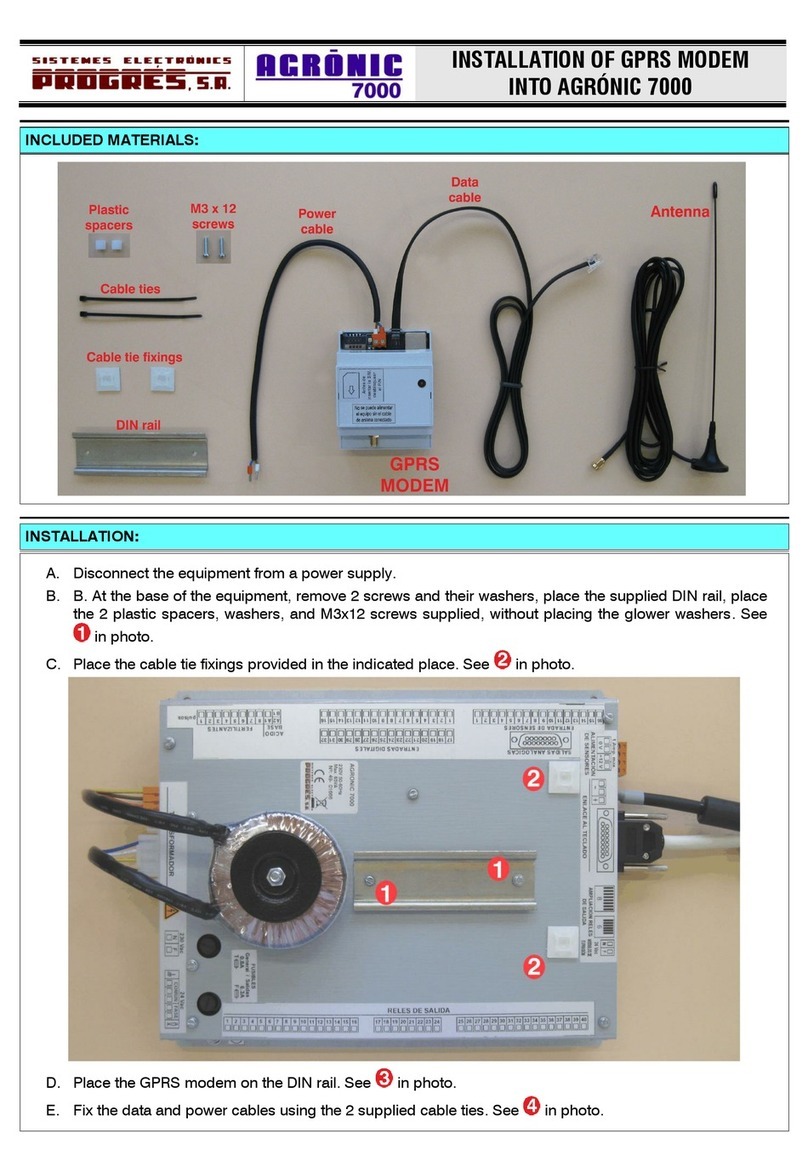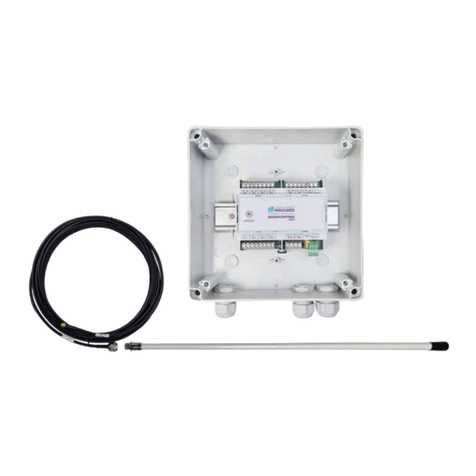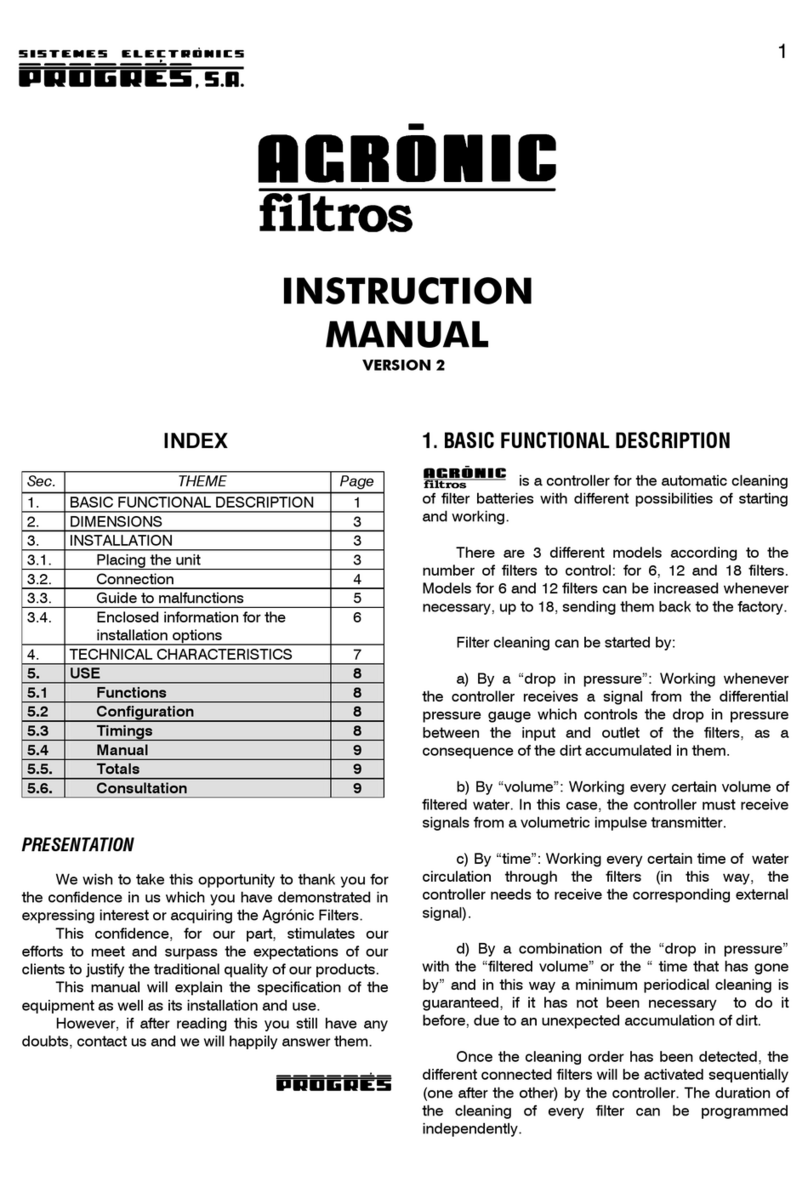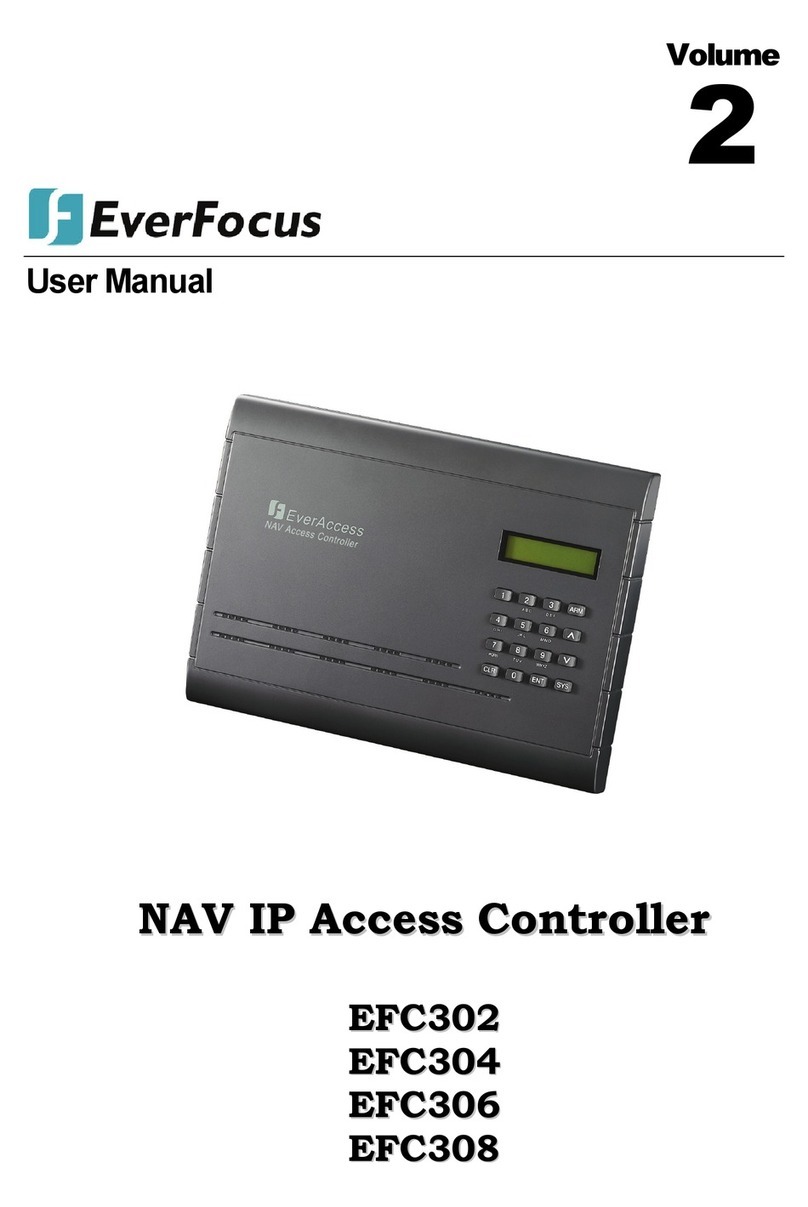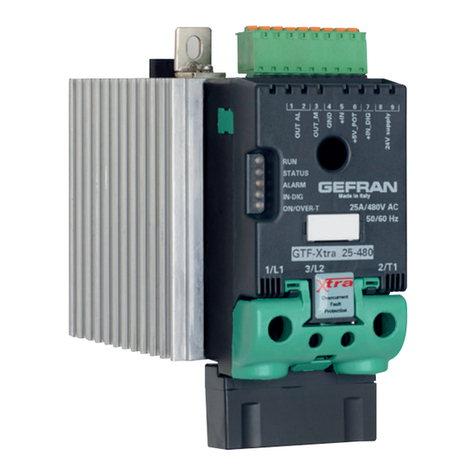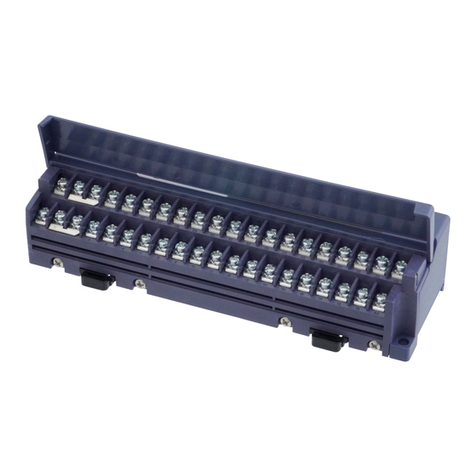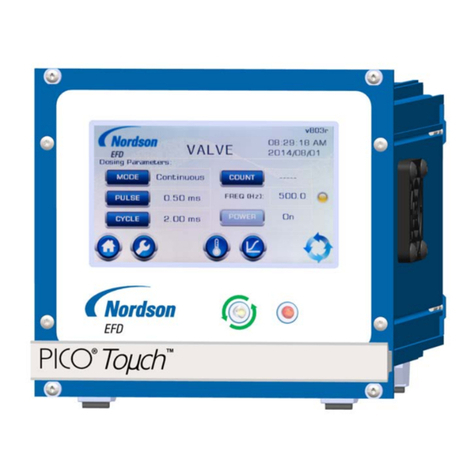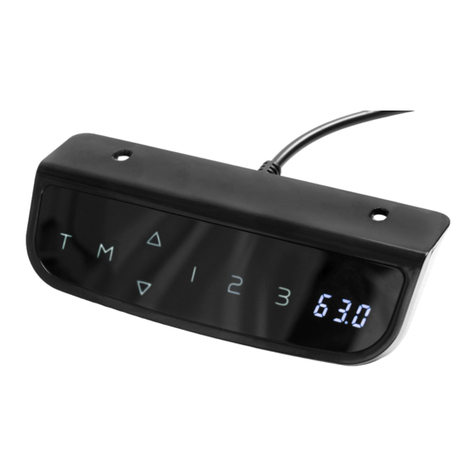Progres AMBITROL 100 User manual

1
INSTRUCTION
MANUAL
MODELS 102 Y 103
INDEX
Sec. Theme Page
1. BASIC DESCRIPTION 1
2. INTRODUCTION 2
3. DIMENSIONS 4
4. INSTALLATION 5
4.1. Placing the equipment 5
4.2. Connection 5
4.3. Supply 5
4.4. Inputs 5
4.5. Outlets 6
5. CONFIGURATION 7
5.1. Inputs 7
5.2. Outlets 8
5.3. Programming 8
6. USE 10
6.1. Programmes 11
6.2.. Curves 12
6.3. Record 12
6.4. Anomalies 13
6.5. Various 13
6.6. Consult 14
7. DETAILED DESCRIPTION OF TYPES 15
8. AMBITROL 100H 23
9. AMBITROL 100HS 23
PRESENTATION
We wish to take this opportunity to thank you for
the confidence in us which you have shown in
expressing interest or adquiring the AMBITROL
102/103.
This confidence, for our part, stimulates our
efforts to meet and surpass the expectations of our
clients to justify the traditional quality of our products.
This manual will explain the specification of the
equipment as well as its installation and use.
However, if after reading this you still have any
doubts, contact us and we will happily answer them.
1. BASIC DESCRIPTION
Model 102/103 is a complete
electronic system for the automatic control of the
environmental parameters in climatic premises such as
farms, greenhouses, drying sheds, cold rooms, etc.
with 8 analogical inputs (for sensors) and 2 digital ones
(to condition working), plus 8 analogical outlets of relay
(all/nothing) expandable, and 3 or 8 analogical,
according to model, (outlets 0/10 V), with ten
programmes of control.
As it is configurable, we can control sensors of
temperature, relative humidity, harmful gases,
lightness, solar radiation, levels, etc.; and act on
numerous windows, fans, heaters, cooling systems,
humidifiers, irrigations, alarms, lighting, engines, etc.
Every one of the controls is configurable in its
inputs, outlets, type of working, conditioners, values of
reference, differentials, alarms, etc.
The references can be programmed by hand
(being possible to modify them personally whenever it
is necessary) or following some curves prefixed by the
user himself once and which are being modified
automatically as time goes by, according to what is
set.
The use of prefixed curves of behaving gives big
nimbleness to those controls in which the references
must be changed periodically.
All the records, anomalies, values and other
information useful for the control are registered in the
memory of the system, being possible to see them on
screen.
WARRANTY
AMBITROL 100 enjoys a WARRANY of two
years against any manufacturing fault.
OPTIONS

2
•Possibility of having 16 outlets of relay.
•Possibility of having 8 analogical outlets
(Model 103).
•Version without box, ready to fit in other
cabinets.
•Version that works with12 V DC (Battery).
•Model AMBITROL 101 (without analogical
outlets).
•Versión “100H” para la humidificación
secuencial.
•Versión “100HS” para la humidificación
secuencial y la regulación de ventanas por
tiempo de apertura.
•Models with software adapted to the
necessities of the clients.
OTHER EQUIPMENT
For those installations where more than 10
controls are necessary, and easy, and nonexpensive
to increase, if it is necessary, we suggest the
AMBITROL 500; which has got a central processing
unit to which can be connected a printer, and some
pheripheric processing units of inputs/outlets which
can be placed hundreds of metres away.
2. INTRODUCTION
Model 102/103 is a complete
environmental controller whose qualities and
peculiarities have to be known by the installer and the
user so that a maximum profit is reached, so we
recommend the careful reading of this Manual.
The manual is divided in four chapters:
a) Introduction (pages 1-4)
b) Installation (pages 5-6)
c) Configuration (pages 7-9)
d) Use (pages 10-22)
The INTRODUCTION is where you are now,
and we recommend its reading to both installers and
users.
The INSTALLATION is the chapter addressed to
the installator who has to connect the equipment to the
other elements that make up the system.
The CONFIGURATION is the chapter which
shows how to configure or adapt the equipment to the
particular necessities of every installation. This work
has to be done by an installator.
The USE is the chapter addressed to the user,
as it contains all the instructions about the
programation and the follow up.
The equipment has and illuminated alpha-
numeric screen with forty characters which shows the
questions that the controller does to the user, his
answers, the programmes and all the other stored
data, the current workings, etc.
SCREEN
It has also got a keyboard with fourteen keys
which are used to acced to the equipment.
There are keys which show numbers from 0 to 9
which will be pressed whenever it is necessary to enter
a number.
The same keys also show the initials of the days
of the week and they will be pressed whenever it is
necessary to enter in the controller one or several
days.
There are two keys with the words "Si"(yes) and
"No" which will be pressed in some cases to answer
yes or no to the questions on the screen.
There is a key with an arrow which is used to
move fast along the data on the screen.
The same key, with the sign "-" is used to enter
negative values.
The key "ENTER" is used to confirm the validity
of the datum typed previously or shown on the screen
placing the cursor below it. This key is bigger than the
others as it is used constantly.
The key "CON" is used to consult the current
state of the programmes which are being carried out
and that of the inputs and outlets.
The key "FUN" is used for entering the six basic
functionsof the controller, as it is shown as follows.
KEYBOARD
ENTRAR =ENTER
FUNCION =FUNCTION
CON =CONSULTATION
DOM =SUNDAY
LUN =MONDAY
MAR =TUESDAY
MIE =WEDNESDAY
JUE =THURSDAY
VIE =FRIDAY
SAP =SATURDAY
DIARIO =DAILY
SI =YES
NO =NO
FUNCTIONS
On pressing the key "FUN" we acced to the
section of FUNCTIONS of the equipment, showing the
following MENU:

3
F1: Programmes
F2: Curves
F3: Record
F4: Anomalies
F5: Configuration
F6: Miscellaneous
To choose a FUNCTION, press its
corresponding number and "ENTER". When pressing
the number you acced to directly to one of the three
above seen screens (the screen also changes with the
key "FUN").
DESCRIPTION OF THE FUNCTIONS
PROGRAMMES
With this function you access to the most
important data of every working programme.
CURVES
Here the values are given in order to form a
curve to be followed by the programme.
RECORD
Statistic of the last seven days for every one of
the programmes.
ANOMALIES
Record of the different anomalies that can take
place in the installation.
CONFIGURATION
Here the equipment is configurated to adapt it to
the necessities of the installation to be controlled. This
is normally done by the installator. It is important not to
access this function without an exact knowledge of
what you are going to modify.
VARIOUS
To leave the alarm in the stand by position or
not, set the clock or leave the equipment temporarily in
stop.
In some screens some letters with inverted
background will appear and they have got the following
meaning.
P= Programme: Programme number.
C= Curve: Activated curve (1) or deactivated (0)
E= Input: Value of the sensor/s of input.
S= Outlet: State of the outlet.
TYPES OF WORKING
We call types of working to the different ways of
working the equipment allows.
TYPE-01
Input of sensors, outlet by relay.
When the value of the sensor is lower than the
value of reference, the outlet is activated until it
overcomes it and reaches the value of the differential.
Examples: Heating, Humidification, etc.
TYPE-02
Input of sensors, outlet by relay.
When the value of the sensor is higher than the
value of reference, the outlet is activated until It
reaches the value of the differential.
Examples: Refrigeration, drying, etc.
TYPE-03
Timetable programme, outlet by relay.
When the day and time programme are
reached, the outlet is activated, finishing when there is
no more time of activation left. Up to 99 periodical
activations can even be programmed, at the same
time. The programme can also be started obeying any
other programme.
Example: Lighting, feeding, irrigation,
humidification by time, when the humidity of a certain
value decreases, etc.
TYPE-04
Input of sensors, analogical outlet (0-10 V).
Every programme is given a reference, a
proportional band and amaximum and minimum
percentage of outlet. When the value of the sensor is
lower than the reference, the outlet increases
proportionally from the minimum to the maximum,
obtaining this last one when the sensor reaches the
value of reference minus the programmed proportional
band. Example: Proportional heating.
TYPE –05
Input of sensors, analogical outlet (0-10 V)
The programme is given a reference, a
proportional band and a maximum and minimum
percentage of outlet. When the value of the sensor is
higher than the reference, the outlet increases
proportionally from the minimum to the maximum,
obtaining this last one when the sensor reaches the
value of reference plus the programmed proportional
band. Example: Forced ventilation.
TYPE-06
Input of sensors, outlet by two relays (open -
close).
Special type to work on windows with lathe so
that the natural ventilation can be made. When the
temperature is higher than the reference, some timings
are made, one of stop and another of opening. The
same happens to close, when the temperature is lower
than the reference minus the differential.
TYPE-07

4
Input of sensors, outlet by relay with modulation
of the working time proportional to the changes of the
sensors.
The programme is given a reference, a
proportional band and a maximum and minimum
percentage of outlet.
When the value of the sensor is lower than the
reference, the oulet increases proportionally from the
minimum to the maximum, obtaining this last one when
the sensor reaches the value of reference
minus the programmed proportional band.
The value of time, called "cycle of modulation",
corresponds to the 100% of the time of activation of
outlet. If the value of proportion decreases, the outlet
will be activated for as long as it corresponds from the
percentage of the cycle of modulation and the rest of
the proportion will not be activated. This will be
repeated once the time of the cycle of modulation is
finished.
Example: proportional heating.
TYPE-08
Input of sensors, outlet by relay with modulation
of the time of proportional activation to the changes of
the sensors. The programme is given a reference, a
proportional band and a maximum and minimum
percentage of outlet.
When the value of the sensor is higher than the
reference, the outlet increases proportionally from the
minimum to the maximum, obtaining this last one when
the sensor reaches the value of reference plus the
programmed proportional band.
The value of time, called "cycle of modulation",
corresponds to the 100% of the time of activation of
outlet. If the value of proportion decreases, the outlet
will be activated for as long as it corresponds from the
percentage of the cycle of modulation and the rest of
the proportion will not be activated. This will be
repeated once the time of the cycle of modulation is
finished.
Example: proportional ventilation.
TYPE-09
Input of sensors, outlet by two relays (open,
close).
Type to work on windows, hatches, motorized
valves etc. with sign / retromessage of position. This
sign and the value of the sensors work on the outlets
of opening and closing to maintain the suitable
position.
3. DIMENSIONS

5
4. INSTALLATION
4.1. PLACING THE EQUIPMENT
The equipment is provided in a hermetically
sealed box (IP 65) with a transparent front cover and
an opaque cover for the connection housing.
For the wall-mounting of the unit, there are two
holed pieces in the upper corners. There are also two
more holes in the inside of the connection housing.
Fix the unit with screws on a wall or similar, so
that the screen is in your field of vision.
Avoid proximity to:
-High voltage devices.
-Transformers.
-Motors or sources of vibration.
-Or any other source of interference which
coud affect the correct working of the unit.
-Also avoid temperatures in excess of 50ºC,
condensation, drips, vibrations, etc.
To maintain the isolation of the unit, it is
essential to keep the transparent and opaque panels
closed.
4.2. CONNECTION
To connect the unit, remove the lower cover to
reach the terminals.
For the cable entries, it is necessary to remove
the relevant dies (this should be done with the
connection cover in place and screwed to avoid
possible breakage).
It is advisable to install the stuffing box
(prensaestopas) in the open dies, which are included
with the unit.
It is advisable to connect the cables to the
terminals with terminal connection, which are also
included with the unit.
4.3. SUPPLY TO THE EQUIPMENT
The power supply should be at 220 V. AC. It is
recommendable to do this as directly as possible from
the general switch, avoiding that the same cable
supplies command lines, relays, switchers, etc.
Do not use the same line which supplies the unit
to supply the outlets of relays.
For unestable or fluctuating voltages, use grid
stabilizers.
It is important to connect the earth terminal, to
discharge the perturbations which there could be in the
supply.
If the equipment is placed on an electric
switchboard, the earth terminals of the equipment
should be joined in star, at the same point of the
switchboared and from this one to the earth terminal
bar with a section equal to the supply cables of the
switchboard.
The equipment is protected in the supply by a
varistor between the phase and the neutral which will
short circuit the fuse on detecting an overload on the
line, and the two supply lines are filtered towards the
earth terminal.
Do not increase the value of the fuse (0.4 A) as
this would suppose the destruction of components. On
the backside of the cover for the connection housing
there are some spare fuses stuck.
Group of three grid supply terminals to the
equipment (right side).
TERMINAL 1: Input of phase of 220 V ac,
protected by the fuse.
TERMINAL 2: Input of neutral of 220 V.
TERMINAL 3: Input of earth terminal
4.4. INPUTS
TERMINAL 1.-Digital input number 1.
TERMINAL 2.-Digital input number 2.
Those two inputs are optojoined to protect the
circuits; the input will be activated when we join them,
with a contact, to terminal number 6.
The contacts of the connection systems which
are connected here must be normally open and free of
tension.
TERMINALS 7 TO 14: Inputs of sensors from
number 1 to number 8.
The inputs of sensors are prepared in the
factory to adapt them to the different values of tension
or power that every sensor can have.
An input without modification has a level of 0 to
5 V. (If those limits are overcome, it can cause
breakage to the system).
TERMINAL 15: Analogical internal earth (it is not
used). TERMINAL 16: Supply of sensors. Earth at 0 V.
TERMINAL 17: Supply of sensors. 17 V positive
stabilizing.
TERMINAL 18: Supply of sensors.18 V negative
without stabilizing.
NOTES: Make sure that the cables from the
inputs of sensors and digitals are installed away from
the lines of tension of the installation.
Make sure that the cables are screened and the
casing is connected to the earth of the equipment.
4.5. OUTLETS
TERMINAL 3:Analogical outlet of 0 to 10 V, nº 3.
TERMINAL 4:Analogical outlet of 0 to 10 V, nº 2.
TERMINAL 5:Analogical outlet of 0 to 10 V, nº 1.
TERMINAL 6:General of analogical outlets.
Avoid to shortcircuit an analogical outlet with the
general of analogical outlets.
TERMINAL 16:Outlet supply sensors -Earth to
0v.

6
TERMINAL 17:Outlet supply sensors -17 V
positive stabilizing.
TERMINAL 18:Outlet supply sensors -18 V
negative without stabilizing.
TERMINAL 19:Outlet of relay nº8 -Normally
outlet of alarm.
TERMINAL 20: Relay outlet nº7.
TERMINAL 21: Relay outlet nº6.
TERMINAL 22: Relay outlet nº5.
TERMINAL 23: Relay outlet nº4.
TERMINAL 24: Relay outlet nº3.
TERMINAL 25: Relay outlet nº2.
TERMINAL 26: Relay outlet nº1.
TERMINAL 27: General of outlets. It is necessary
to supply (220 or 24 V) so that it can go out through
the relays.
The general is protected with the fuse of outlets
for a maximum power of 2.5 A.
Do not exceed a 1 A current load for each outlet
by relay.
Every contact of relay is protected by a varistor
which avoids the sparks or interferences which are
produced when we open the contact with inductive
charge.
BE CAREFUL WITH THE ANALOGICAL
OUTLETS OF THE AMBITROL!
In the AMBITROL equipments with analogical
outlets of 0 to 10 V, it is necessary to protect these
outlets with screened cable. What is more, this cable
must never be installed by the power lines.
The screen of the cable will be connected to the
earth terminal by one of its ends. If there is not an
earth terminal, it will be connected to the general of
analogical outlets.
These outlets are normally connected to
regulating equipment, so we have to take into account
that some of these equipment, on being disconnected
from the grid, can produce an overload in the outlets.
In these cases, we have to install a device which on
disconnecting the regulating equipment of the grid,
also disconnects the sign of 0-10 V. (this anomaly has
been detected in gas regulators).
It is also necessary to screen the analogical
inputs of the sensors and to place them away from the
power lines.
If the equipment is placed, because there is no
other possibility, next to contactors with inductive
charges, it may be necessary to install, in its contacts,
spark suppressors, so that these do not affect the
equipment.
CONNECTION SCHEMES: INPUTS AND SUPPLY
CONNECTION SCHEME: OUTLETS
5. CONFIGURATION
The first thing to be done when the equipment is
installed is to configurate it. This is to be done by the
installator.

7
To do so, press the "FUN" key and choose
option 5, which shows the MENU OF
CONFIGURATION.
F5: Configuration
F6: Various
CONFIGU.:Programmes=
1
Inputs=2 Outlets= 3
5.1. INPUTS
Normally the INPUTS are already configurated
and prepared in the circuit in the factory, so the
following data is already configurated in memory.
If you choose option 2 (INPUTS) of the menu of
CONFIGURATION, you will see the following screen:
Number of input= 0
ANALOGICAL INPUTS
The maximum number of analogical sensors to
be connected is 8.
Every sensor is given a number which
corresponds to the input to which it is connected. This
input has already been predetermined and
configurated in the factory.
One sensor can give value to several
programmes.
The number of measure unit is used to give a
name to the type of value which controls the sensor.
Num. of input= 1
Measure unit= 01
Here is a list of the measure units.
01-Temperature ºC 08-Radiation Wm2
02-Relat. humidity %HR
09-Units Uds
03-Lighting Klx 10-Pressure Psi
04-Relation %11-Flow m3h
05-Speed m/s
12-Flow l/h
06-Direction º13-Carbon dioxide
C02
07-Acidity pH 14-Ammonia NH3
Every sensor has a tare (calibration) in relation
to a pattern. It is important not to modify this value,
unless a calibration has been done.
The maximum value of the tare is +120 or 12.0.
Num. of input=8
Tare= 03.5%HR 76.3
To modify the value of the tare we have to
calculate the error of the reading of the sensor and add
or deduct it to the value of the tare.
Example: Tare = 03.5% HR 76.3
If the correct value, according to the pattern,
was 75.0% HR, compared with the value of the
reading (76.3) there is a difference of minus 01.3%,
which has to be deducted from the value of the tare
(3.5 -
1.3 = 2.2%) resulting as follows: Tare =02.2% Hr
75.0.
If the tare has to be negative, enter first the
value and then press the key "-".
To the right of the value of the tare it indicates
the value of the sensor; this will be useful in the
programmes which give us averages of two sensors,
being here where you can see sensor by sensor.
To escape, enter the sensor "0" or press "FUN"
or "CON".
DIGITAL INPUTS
The two digital inputs included in the
programme, can be used as external conditioners of
the programmes (for levels, etc) or as counters of
impulses (to register the consumption of water and
feed, etc).
To configurate them, when the screen demands
the number of input, answer with "9".
The next question will appear on the screen:
Counting 1 (Yes/No)=Yes
With "Yes" it will be input of counting, with "No" it
will be conditioning input.
Answering "Yes", the next question will be :
Counting 1 (Yes/No)=Yes
Impulse value 1= 01.0
The value of impulse corresponds to the
quantity equivalent to every impulse received from a
counter of water, weight, etc. The maximum value is
12.0. For the input nº 2 it will ask the same.

8
5.2. OUTLETS
CONFIGU.:Programmes=
1
Inputs=2 Outlets= 3
If the option 3 (INPUTS) is chosen from the
menu of CONFIGURATION we will be able to
configurate the analogical outlets with the following
screen.
It is not necessary to configurate the outlets by
relay.
Num. of outlet=0
(analogical 0-10v)
The maximum number of analogical outlets is 3
(optionally 4) in Model 102 and 8 in Model 103.
The analogical value goes from 0 to 10 V. and it
corresponds to the 0 to 100% that will be shown on the
screen as value of outlet.
This outlet is normally connected to controllers
of speed, lightness, powered valves, hatches
controllers, etc.
It is possible that, for example, a speed
controller needs to work from 2 to 10 volts, for the
engine to start well at low speed; then, in the minimum
tension it will be given a value of 02.0 volts (in this
case the 0% corresponds to 0 volts and the 1% to 2
volts).
Num. of outlet= 3
Minimum tension 00.0V
We can also fix beforehand the level of
maximum tension.
Num. of outlet= 3
Maximum tension 10.0V
The equipment which receives the tension may
need the inverted sign (from 10 to 0V.) in this case,
enter in minimum tension 10.0V and in maximum
tension 00.0V.
To escape, enter the outlet "0" or press "FUN" or
"CON".
5.3. PROGRAMMES
CONFIGU.:Programmes=1
Inputs=2 Outlets= 3
Choosing option 1 (Programmes) from the menu
of CONFIGURATION you can configurate
programmes, but it is necessary to configurate the
inputs and outlets before, as they are related to the
programme.
First, we can see the following screen asking for
the number of PROGRAMME we want to access, give
the number and "ENTER". The equipment has
capacity for 10 programmes.
Num. of programme= 00
(to configurate)
Once the number has been entered, we can see
the following screen.
P05
Type of working=1
In the question "type of working of the
programme" we have to take into account what it is
going to control, because the number of type is what
conditions totally the questions and answers of the
programme.
(At the end of this Manual there is a detailed
description of every TYPE).
If the value 00 is entered, it erases all the data
of this programme.
Once the type is entered, it will ask for the text
and a number; these will be used to identify the type of
control and where the programme is working.
P05
Text=00 Number=0
The list of texts is as follows.
01-TERM (Thermostat)
09-ALAR (Alarm)
02-CALE (Heating)
10-TIEM (Time)
03-VENT (Ventilation)
11-AGUA (Water)
04-HUMI (Humidification)
12-ALIM (Feed)
05-VTNA (Window)
13-CONT (Control)
06-REFR (Refrigeration)
14-ILUM (Lighting)
07-NAVE (Premise)
15-SALA (Room)
08-ZONA (Area)
16--A
The number is used to identify different
programmes which have the same function, for
example several thermostats which will be given
different numbers to differenciate them.
A programme normally needs to read from some
sounds (inputs) placed in the installation to compare
that value with the programmed one and in this way
act on the corresponding outlet.
Every programme can read one or two sounds,
if there are two it takes the average .
P05 TERM-1
Num. of inputs= 00

9
In the question of "inputs", if the number of
sensor is not entered, the programme will not go on to
the next question.
One sound can be read by several programmes.
In the programmes where a sign of
retromessage is used, it will ask for the number of
input of this retromessage.
All the programmes have an outlet, which can
be of relay or analogical. Depending on the type of
programme, the controller will know which type it is.
To the question "number of outlet" we can also
answer with 0; in this way the programme does not act
externally, but it can condition other programmes.
P05 TERM-1
Num. of outlet=00
The last outlet of relay (nº 8) is normally used as
outlet of alarm. (Explanation in section ALARM).
Several programmes can act on the same outlet
of relay, but the priority is for the activation.
The programmes type 6 and 9 (windows) need
two outlets to work, one that opens and another that
closes. This question will be answered with the
number of outlet that has to open, and the equipment
will automatically assign the following number to
close. For this reason, it is necessary to assign a
number of outlet that is followed by another one which
has not been assigned.
Any programme can be "conditioned" by another
one and it has a priority effect in the outlet.
P05 TERM-1
Conditioning pro.=00
It can also be conditioned by one of the two
existing digital inputs (to connect securities external to
the equipment) if they are not used to count.
For the input "1" enter the code 81 and for the
input "2" the code 82, in the blank for the conditioning
programme.
Next it will ask how it will be affected, and we
have to answer with one of the following codes:
P05 TERM-1
Affects on code= 00
AFFECTS ON
CODE TYPES 4-5-7-8-9TYPE 6
TYPES1-
2
00 Outlet at 0% Stop Stop
01 Outlet at100% Close Start
02 Outlet at minimum Open
03
Outlet at maximum
04 Outlet at 25 %
05 Outlet at 50 %
06 Outlet at 75 %
07 Limits at 25 %
08 Limits at 50 %
09 Deducts the % of the programme,
minus % of the conditioning.
10 Adds the % of the programme, plus %
of the conditioning.
11 Outlet at 0 %, plus the 10 % of the
outlet of conditioning.
12 Outlet at 5 %, plus the 10 % of the
outlet of conditioning.
13 Outlet at 5 %, plus the 20 % of the
outlet of conditioning.
Then it asks again for a new number of
programme; to escape enter "00" or "FUN" or "CON".
The TIMING PROGRAMMES (type 3) have a
variant in the questions of CONFIGURATION of
programmes, in these programmes it asks for the time
format we want to programme them in.
P04 WATER-1
(h:m):0 (m.s):1 =00
A "0" is for hours and minutes and a "1" for
minutes and seconds. If there is an electric cut while
the programme is working, it does not discount the
time the cut lasted (starting the timing in the point
where it was interrupted, but it will do so if we add 10
to the values of this question, entering a 10 or a 11
respectively (losing the time of temporization
corresponding to the cut.

10
6. USE
6.1. PROGRAMMES
To acced to every one of the programmes of
values (not of Configuration) press the key "FUN" and
choose option 1, then it will ask the number of
programme.
F1: Programmes
F2: Curves
Num. of programme= 00
(for values)
Once we have entered the number, it shows the
following screen, in which for two seconds, it informs
about the type of working of the programme.
P03 HEAT-1 C0
Type of working= 1
Once the timing is finished, in the second line,
the message of type of working is normally replaced by
the value of the reference.
P03 HEAT-1 C0
Reference= 22.0 ºC
The cursor is placed in the value of the curve
"C". If the value is zero "C0", the datum of the
reference will be entered manually.
If you want that the value of reference changes
automatically as time goes by, we will have to activate
the curve that every programme has, giving the value
"1".
If you do not want to modify the number of
curve, press the key "ENTER" and then it will ask the
value of reference.
P02 VENT-1 C1pos=018
Reference= 22.6 ºC
Once the curve is activated, it will ask the
position (pos) in the curve, which goes from 0 to 250
days.
The position increases automatically every day
at 0 hours and can be modified at any moment.
The value of reference is updated automatically
every hour.
With the cursor placed in "pos", we can modify
the value or press directly "ENTER", placing the cursor
at the right side of the lower line.From this point,
pressing the key with the arrow we can modify again
"pos". When the curve is activated, the value of
reference can not be modified directly.
Once the value of reference has been entered, it
asks for the "differential" of working; This is done in the
types of outlet by relay (types 1-2-6, except type 3,7,8
and 9).
P02 VENT-1 C1pos=018
Differential= 00.5 ºC
This value is added or deducted, according to
the type of working, to the reference to calculate the
stop of the working.
In the types with analogical outlet (types 4-5), of
proportional action (types 7-8) and proportional
window (type 9), we are asked for the "proportional
band", which is also added or deducted to the
reference so that the value of outlet reaches the
maximum of its value.
For these types, it will later ask for the maximum
and minimum value of outlet. This is useful to maintain
tops in the value of outlet even though the value of the
sensor is moved from the referenced values.
If the curve is active, we will not be able to
change directly the maximum and minimum values.
Every programme, except the types 3-6 (timing,
window), will be asked some values of high and low
alarm.
P03 HEAT-1 C0
High alarm(+)= 03.0
P03 HEAT-1 C0
Low alarm(-)= 02.5
These values are added (high) and deducted
(low) to the reference and, if the value of the sensor is
superior to the added value or is inferior to the
deducted value and it stays like that for at least 30
seconds, the relay of alarm (outlet 8) will be activated
until this condition disappears.
The programme, date and time when this
happened will also be registered in the section of
ANOMALIES.
If the values of alarm are entered in negative,
the alarm will be activated as long as the value of the
sensor is between the two values of alarm.
At the end of every programme, it asks if we
want to act on the outlet manually.
P03 HEAT-1 C0
Manual (Yes/No)= No
If we answer with the key "SI" (YES) and
"ENTER", different screens will appear depending on
the type of working:
FOR TYPE 1 AND 2 (outlet by relay)
P03 HEAT-1 C0
Start:1 Stop:0 = 0

11
A "1" starts the outlet and a "0" deactivates it,
this happens indefinitely in all the types, as long as we
do not answer "NO" to the question of Manual
(Yes/No).
FOR TYPE 3 (timing relay)
P03 WATER C0
Start:1 Stop:0 = 0
FOR TYPES 4-5 (analogical) AND 7-8-9 (proportional)
We enter the value that we want in the outlet.
P03 HEAT-1 C0
Outlet= 089%
FOR TYPE 6 (windows)
P03 VTNA-1 C0
Stop:0 Op.:1 Cl.:2=0
0:Stop 1:Open 2:Close
6.1.1. TIMING PROGRAMMES (TYPE 3)
In the timing programmes, type 3, we will be ask
some different questions about the values of the
programme:
P03 HEAT-1 C0
Start=08:00
P03 HEAT-1 C0
Days=SMTWTFS
P03 HEAT-1 C1pos=015
T. working= 00:00
P03 C0
N. workings= 00
The "start" is the time when the programme will
start working in relation to the question of "days".
To programme the days, press the keys that
have the days on them, pressing once to programme it
and once to erase it. To enter or erase all the days
press the key "daily".
A variant in the "start" of the programme is that
instead of start working by timing it can do so by
command of another programme, to do so in the value
of the time of start, we will enter the code 90 or 91 and,
in the minutes, the number of programme that will start
this one.
The difference between code 90 and 91 is that
the first one will stop if the programme which started it
goes from start to stop and the second one will not
stop until it has finished all the programme.
The programmes with analogical outlet or of
proportional action are started when the outlet is over
60% and stop when it decreases below 40%
Then it asks if it will work with curve. If we
answer yes, it also asks for the position.
The next question is "Time of working", which is
the time that the outlet will be working.
The "Number of workings" is the number of
times that it will repeat the working.
The "Frequency" is the time between the starts
of different workings.
Both the "Time of working" and the "Frequency"
can work in hours and minutes or in minutes and
seconds. (This selection will be done in Configuration).
If the programme is started manually, the outlet
will start during the programmed time and the cycles,
cancelling automatically the MANUAL state in order to
be activated automatically.
If there is an electric cut during the time of start,
when the power is back the programme will already be
started.
If the programme is started and it has not
finished the previous working completely, the number
of workings will be added.
To cancel the time left when the programme is
working, start the MANUAL at Stop and then take out
the Manual answering "NO".
6.1.2. WINDOWS (TYPE 6)
Another variant in the questions is, for the type 6
that works on windows:
P01 VTNA-1 C0
Reference= 24.0 ºC
P01 VTNA-1 C0
Differential= 05.0 ºC
P01 VTNA-1 C0
Timing open = 05 s
P01 VTNA-1 C0
Pause open = 128 s
P01 VTNA-1 C0
Timing close= 08 s
P01 VTNA-1 C0
Pause close= 128 s
P01 VTNA-1 C0

12
Manual (Yes/No)= No
The reference is the value at which it will start to
open when the value of the sensor is superior to this
one.
It will close when the value of the sensor is
inferior to the value of the reference minus the
differential.
When it is at open or close, some timings take
place so that the climatic changes, produced on
moving the windows, are taken correctly by the
sensors.
First the pauses of open or close take place and
then the timings of open and close and they will be
repeated when the value of the sensor has to open or
close.
The timings can be programmed up to 99
seconds and the pauses up to 999.
6.2. CURVES
The curve of every programme is an important
feature that the programme has and that can be very
useful in applications such as the automatic increase
and/or decrease of temperature, the automatic
modification of the time of lighting, etc.
To enter in the curves of every one of the
programmes, press the key "FUN" and choose option
2, and it will ask for the number of programme.
F1: Programmes
F2: Curves
Num of programme= 00
(for curves)
Every programme has a curve, except the types
4-5-7-8-9, in which there is a seond curve that contains
the maximum and minimum values of outlet. For this
reason, it asks, in these types, to which of the two
curves we want to access.
P02 VENT-1C0
Once the number of curve is entered, it will ask
for the position and the reference of the first point out
of the four that each curve contains. At the right of the
number of curve it shows us the point which is asking.
P02 VENT-1C1 Point1
Pos=000 Ref= 00.0 ºC
Every point has a value of situation in the time,
in days, and some values of reference according to the
type of working.
The curves can be compared with patterns
which are used by the programmes in order to do a
variable and automatic control.
Here we can see a simple example.
P02 HEAT-1C1 Point1
Pos=003 Ref= 29.8 ºC
Pos=008 Ref= 27.5 ºC
Pos=020 Ref= 25.0 ºC
Pos=045 Ref= 20.0 ºC
This curve would control the temperature as the
animal grows, for example.
Every point corresponds to days of growth and
the reference of temperature will change in the values
that correspond within these points.
We have to say that if point 1 does not
correspond to 0 days, the value of reference that the
programme will take will be fix, until reaching the
position of point 1; in the example the first three days
of reference will be 29.8 ºC.
The same happens from the fourth point; in the
example after 45 days the value will stay at 20.0ºC.
6.3. RECORD
The record is an statistical record of the last
seven days, for everyone of the programmes.
To acced to the record of every programme,
press the key "FUN" and choose option 3, and it will
ask for the number of programme.
F3: Record
F4: Anomalies
Num. of programme= 00
(for record)
Once the number is entered, it will show today's
record. To see the previous six days, press the key
with arrow.
To see another programme, press the key
"ENTER". To escape press the keys "FUN" or "CON".
In the upper line of the record it shows at the
left, the text of the programme, in the center, the day
and month and at the right the hours and minutes in
which the programme has been working if the outlet is
by relay (type 6 no). If it is analogical (types 4-5) or
proportional (types 7-8-9) outle, it shows the average
of the day of the percentage of the value of the outlet.
At the lower line, at the left, it shows the highest
value of reading of the sensor, at the center the
average of all the readings of the day, and at the right
the lowest one.
TERM-121/08 (04:48)
20.2 19.6 18.4 ºC
For the reading of the accumulated values in
every one of the inputs/counters (if they are
configurated as such) enter in the function of Record.

13
When it asks for the number of programme,
enter "11" for the input 1 and "12" for the input 2.
The first value shown corresponds to the
accumulated from today. To see the six previous days,
press the key with the arrow.
The data are not updated while you are seeing
the record of counting.
23/04
Counter 1= 00001
6.4. ANOMALIES
The anomalies is a record of the incidences that
have taken place and have affected the correct
working of what it is controlled.
To enter in anomalies, press the key "FUN" and
choose option 4, then it will show the first anomaly, if
there is any.
F3: Record
F4: Anomalies
The maximum number of anomalies registered
is 15, if there are more than 15 it will cancel the oldest
one.
At the right upper line of every anomaly it shows
the text "E.y/n" (Erase? yes or no). If you press "YES"
it erases it and goes to the next one, not to erase this
one press "NO". On reaching the last anomaly it goes
back to Functions.
Here is a list of the different anomalies:
-Electric supply failure: If there is an electric
supply failure which is longer than a minute and
shorter than 24 hours, it will be registered as follows.
Electric cut. E. Y/n
15/04 from 21:34 to 23:17
-Without battery: If there is a disconnection of
the equipment superior to four days the memory of the
record and of anomalies may be erased. The
configuration, the programmes and the curves are not
erased.
Without battery E.y/n
27/03
-Alarm in programme: Any programme to which
we have given values in high or low alarm and the
value of the sensor is superior to these ones, for at
least thirty seconds, the outlet of alarm will be
activated and the anomaly will be registered.
Alarm in P03 E. Y/n
27/03 15:06
6.5. VARIOUS
To acced to VARIOUS, press key "FUN" and
choose option 6 and it will show a MENU OF
VARIOUS.
F5: Configuration
F4: Various
VARIOUS: Alarm=1
Clock=2 Stop=3
6.5.1. ALARM
Choosing option "1", we can inhibit the outlet of
the alarm, both when it is working or not, to use it and
in this way, use the outlet as a normal one.
Alarm (Yes/No)= Yes
If we answer with "Yes" it will ask if we want that
the outlet of alarm is normally closed. If we answer
"Yes", the start will be closed until there is an alarm or
an electric cut.
Alarm (Yes/No)= Yes
Normal. Closed= No
6.5.2. CLOCK
Choosing option "2" we can set the time in the
internal clock.
Thur.15:26 14/06/00
-Set time-
6.5.3. STOP
With the option "3" we can set the equipment at
STOP, which means that all the outlets are
disactivated.
In STOP (Yes/No)= No
6.6. CONSULT
The option of CONSULT is used to examine, in
a simple way, the state of the inputs and outlets of
every programme.
To enter this section, press the key "CON".
From nowonwards the key with arrow or with CON
move the programmes on the screen.
To have direct access to the consult of a
programme, enter its number. The programme 10 is
the key "0".

14
The first screen that is displayed when we press
the key "CON", informs about the time and date. It also
indicates the quantity of anomalies that have taken
place or if the equipment is at STOP.
Mon. 15:23 17/07/00
A102 Anomalies=05
Mon. 15:23 17/07/00
A102 *STOP*
The other screens of consult show us the data
of every one of the programmes.
In the upper line it indicates the number of the
programme that is being consulted, then the text and
at the right the value of the input of the sensors.
At the lower line it shows the value of the outlet,
both in Manual and in Alarm.
The values of the inputs and outlets are updated
on the screen every second.
P05 TERM-1 E 18.9 ºC
S Start(man.) ALARM
The value of the input changes in the timing
programmes (type 3) as no value of sensor is
indicated, but we indicate the value of time that is left
to finish the working. If it is in hours and minutes, the
format is 00:00 if it is in minutes and seconds 00.00.
And, at the right of the lower line it shows in brackets
the number of cycles that are left to finish.
P08 TMP-0 E 01:33
S Pause (02)
The value or state of the outlet can vary
according to the type of working, here are some
examples:
S Start
S Stop
S 000 %
S 100 %
S Open
SClose
S Pause
S Paus. O
S Paus. C
An asterisk (*) will appear between the "S" and
the value of outlets, in the programmes that in that
moment are being conditioned by another programme
or by a digital input, to indicate so.
An arrow up or down can also appear here, in
the programmes with analogical outlet or of
proportional action, indicating that the value of outlet
has reached the maximum or minimum programmed
value.

15
7. DETAILED DESCRIPTION OF THE TYPES
TYPE 1
Input of sensors, outlet by relay.
When the value of the sensor is lower than the
value of reference, the outlet is activated until it
overcomes it and reaches the value of the differential.
Examples: Heating, Humidification, Minimum
Alarm etc.
CONSULT
P06 HUMI-4 E 78.5%HR
S Stop
PROGRAMME
P06 HUMI-4 C0
Reference= 75.0%HR
Differential= 03.0%HR
High alarm(+)= 00.0
Low alarm(-)= 00.0
Manual (Yes/no)= No
CURVE 1
P06 HUMI-4 C1Pto1
Pos=000 Ref=00.0%HR
Pos=000 Ref=00.0%HR
Pos=000 Ref=00.0%HR
Pos=000 Ref=00.0%HR
Pos=000 Ref=00.0%HR
CONFIGURATION
P06 HUMI-4
Type of working= 1
Text= 04 Number= 4
Num. of inputs= 5 0
Num. of outlet= 06
Conditioning Pro.= 00
Affects in code= 00
RECORD
HUMI-421/06 (01:05)
78.9 77.5 74.3 ºC
VALUE OF SENSOR
High alarm
20.0
DIFFERENTIAL
15.0
REFERENCE
10.0
5.0
Low alarm
START
STOP

16
TYPE 2
Input of sensors, outlet by relay.
When the value of the sensor is higher than the
value of reference, the outlet is activated until it
reaches the value of the differential.
Examples: Refrigeration, drying, Maximum
alarm, etc. CONSULT
P05 TERM-1 E 18.9 ºC
S Start
PROGRAMME
P05 TERM-1 C0
Reference= 20.0%ºC
Differential= 01.5%ºC
High alarm(+)= 04.0
Low alarm(-)= 06.0
Manual (Yes/no)= No
CURVE 1
P05 TERM-1 C1Pto1
Pos=000 Ref=24.0%ºC
Pos=012 Ref=22.0%ºC
Pos=020 Ref=21.3%ºC
Pos=032 Ref=19.5%ºC
CONFIGURATION
P05 TERM-1
Type of working= 2
Text= 01 Number= 1
Num. of inputs= 1 0
Num. of outlet= 07
Conditioning Pro.= 00
Affects in code= 00
RECORD
TERM-1 21/06 (03:32)
20.2 19.6 18.4 ºC
High alarm
VALUE OF SENSOR
20.0
REFERENCE
DIFFERENTIAL
15.0
10.0
Low alarm
5.0
START
STOP
TYPE 3
Timing programme, outlet by relay.
When the day and time programmed are
reached, the outlet is activated, finishing when there is
no more time of activation left. Up to 99 periodical
activations can be programmed, at the same time.
The programme can also be started obeying to
any other programme.
Example: Lighting, feeding, irrigation,
humidification by time, when the humidity of a certain
value decreases.
CONSULT
P04 WATER-1 E 00:12
S Start
PROGRAMME
P04 WATER-1 C0
Start= 08:00
Days= SMTWTFS
T.working= 00:15
N. workings= 02
Frequency= 06:00
Manual (Yes/No)= No
CURVE1
P04 WATER-1 C1Pto1
Pos=000 Ref=00:11
Pos=025 Ref=00:14
Pos=045 Ref=00:19
Pos=130 Ref=00:28
CONFIGURATION
P04 WATER-1
Type of working= 3
Text= 01 Number= 1
Num. of outlet= 03
(h:m):0 (m.s):1 00
Conditioning Pro= 00
RECORD
WATER-1 27/06 (00:30)

17
TYPE 4
Input of sensors, analogical outlet (0-10 V). The
programme is given a reference, a proportional band
and a maximum and minimum percentage of outlet.
When the value of the sensor is lower than the
reference, the outlet increases proportionally from the
minimum to the maximum, obtaining this last one when
the sensor reaches the value of reference minus the
programmed proportional band.
Example: Proportional heating.
CONSULT
P03 HEAT-1 E 21.5 ºC
S 025%
PROGRAMME
P03 HEAT-1 C0
Reference= 22.0 ºC
Pro. Band= 02.0 ºC
Min= 00% Max= 090%
High alarm(+)= 00.0
Low alarm(-)= 03.8
Manual (Yes/no)= No
CURVE1
P03 HEAT-1 C1Pto1
Pos=000 Ref=34.0 ºC
Pos=017 Ref=26.5 ºC
Pos=035 Ref=23.5 ºC
Pos=045 Ref=22.0 ºC
CURVE2
P03 HEAT-1 C1Pto1
Min=00% Max=090%
Min=00% Max=085%
Min=00% Max=075%
Min=00% Max=070%
CONFIGURATION
P03 HEAT-1
Type of working= 4
Text= 02 Number= 1
Num. of inputs= 30
Num. of outlet= 03
Conditioning Pro.= 00
Affects in code= 00
RECORD
HEAT-1 24/06 (047%)
22.1 21.2 19.7 ºC
High alarm
15.0
VALUE OF
SENSOR
12.5
REFERENCE
10.0
PROPORTIONAL BAND
7.5
Low alarm
5.0
100 %
MAXIMUM
MINIMUM
000 %

18
TYPE 5
Input of sensors, analogical outlet (0-10 V). The
programme is given a reference, a proportional band
and a maximum and minimum percentage of outlet.
When the value of the sensor is higher than the
reference, the outlet increases proportionally from the
minimum to the maximum, obtaining this last
one when the sensor reaches the value of reference
plus the programmed proportional band.
Example: Forced ventilation.
CONSULT
P02 VENT-1 E 24.8 ºC
S 100%
PROGRAMME
P02 VENT-1 C2pos=012
Reference= 22.5 ºC
Pro. Band= 02.0 ºC
Min= 10% Max= 100%
High alarm(+)= 04.0
Low alarm(-)= 00.0
Manual (Yes/no)= No
CURVE1
P02 VENT-1 C1Pto1
Pos=000 Ref=285 ºC
Pos=017 Ref=265 ºC
Pos=035 Ref=235 ºC
Pos=045 Ref=220 ºC
CURVE2
P02 VENT-1 C1Pto1
Min=05% Max=080%
Min=12% Max=090%
Min=18% Max=100%
Min=25% Max=100%
CONFIGURATION
P02 VENT-1
Type of working= 5
Text= 02 Number= 1
Num. of inputs= 14
Num. of outlet= 02
Conditioning Pro.= 00
Affects in code= 00
RECORD
VENT-1 21/06 (083%)
24.9 23.4 22.4 ºC
In the inputs of the powermeter of
retromessage of window, the maximum and minimum
values can be configured, within a margin from 0 to 5
volts. To do so, enter in Function-5-Configurate-2-
Inputs, and it will ask for the number of input, then
enter the number to which the powermeter is
connected to. At unit of measure answer with 4.
Next it will ask for the minimum value of tension
that the powermeter gives when the window is closed;
if for example, it is 1.2 volts enter 12; do the same with
the maximum value.
High alarm
15.0
VALUE OF
SENSOR PROPORTIONAL BAND
12.5
REFERENCE
10.0
7.5
Low alarm
5.0
100%
MAXIMU
M
MINIMU
M
000%
The type of working 5, normally used for
forced ventilation, adds the feature of modulating the
analogical outlet of 0-10 volts when the temperature
drops 1ºC below the programmed reference, applying
a regulation equal to the proportional band. The cycle
of modulation is of 300 seconds.

19
TYPE 6
Input of sensors, outlet by two relays (open -
close).
Special type to work on windows with lathe so
that the natural ventilation can be made.
When the temperature is higher than the
reference, some timings are made, one of stop and
another of opening.
The same happens to close, when the
temperature is lower than the reference minus the
differential.
CONSULT
P01 VTNA-0 E 24.8 ºC
S Open
PROGRAMME
P01 VTNA-0 C0
Reference= 24.0 ºC
Differential= 02.0 ºC
Tim. Open= 05 s
Pause Open = 128 s
Tim. Close= 100 s
Pause Close= 100s
Manual (Yes/no)= No
CURVE1
P01 VTNA-0 C1Pto1
Pos=000 Ref=24.8 ºC
Pos=045 Ref=21.3 ºC
Pos=000 Ref=000 ºC
Pos=000 Ref=000 ºC
CONFIGURATION
P01 VTNA-0
Type of working= 6
Text= 05 Number= 0
Num. of inputs= 87
Num. of outlet= 04(5)
Conditioning Pro.= 00
Affects in code= 00
RECORD
VTNA-0 21/06
24.9 23.4 21.7 ºC
High alarm
20.0
REFERENCE
15.0
DIFFERENTIAL
10.0
Low
alarm
5.0
OPEN
STOP
CLOSE

20
TYPE 7
Input of sensors, outlet by relay with modulation
of the working time proportional to the changes of the
sensors.
The programme is given a reference, a
proportional band and a maximum and minimum
percentage of outlet.
When the value of the sensor is lower than the
reference, the outlet increases proportionally from the
minimum to the maximum, obtaining this last one when
the sensor reaches the value of reference minus the
programmed proportional band.
The value of time, called "cycle of modulation",
corresponds to the 100% of the time of activation of
outlet. If the value of proportion decreases, the outlet
will be activated for as long as it corresponds from the
percentage of the cycle of modulation and the rest of
the proportion will not be activated. This will be
repeated once the time of the cycle of modulation is
finished.
Example: proportional heating.
CONSULT
P03 HEAT-1 E 21.5 ºC
S 025 %
PROGRAMME
P03 HEAT-1 C0
Reference= 22.0 ºC
Pro. Band= 02.0 ºC
Min= 00% Max= 090%
High alarm(+)= 00.0
Low alarm(-)= 03.8
Manual (Yes/no)= No
CURVE1
P03 HEAT-1 C1Pto1
Pos=000 Ref=34.0 ºC
Pos=017 Ref=26.5 ºC
Pos=035 Ref=23.5 ºC
Pos=045 Ref=22.0 ºC
CURVE2
P03 HEAT-1 C2Pto1
Min=00% Max=090%
Min=00% Max=085%
Min=00% Max=075%
Min=00% Max=070%
CONFIGURATION
P03 HEAT-1
Type of working= 7
Text= 02 Number= 1
Num. of inputs= 3 0
Num. of outlet= 03
Modulation cycle= 000
Conditioning Pro.= 00
Affects in code= 00
RECORD
HEAT-1 21/06 (047%)
22.1 21.2 19.7 ºC
High alarm
20.0
REFERENCE
15.0
Value of sensor
10.0
PROPORTIONAL BAND
Low Alarm
5.0
Maximum
100%
Minimum
0%
Staterelay
of outlet
This manual suits for next models
2
Table of contents
Other Progres Controllers manuals
Popular Controllers manuals by other brands

Taconova
Taconova FWCK Installation and operating instructions for manual and remote control options
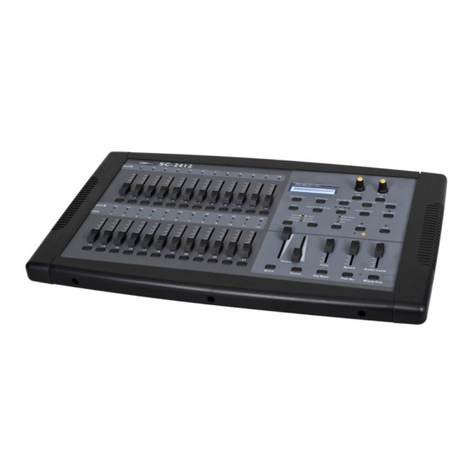
Show Tec
Show Tec SC-2412 user manual

Preferred Utilities
Preferred Utilities Quanta-Flame 5004-890 quick start guide

Raven
Raven Hawkeye installation manual
HTC
HTC Vive Tracker Developer Guidelines
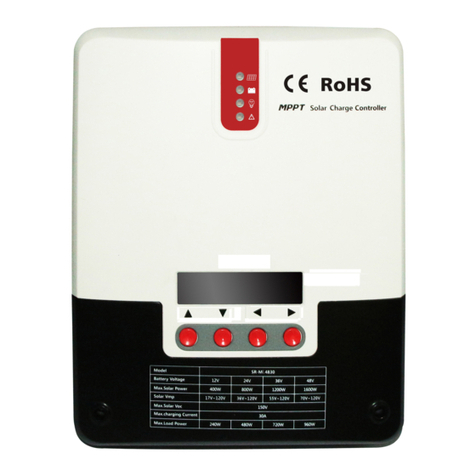
Srne
Srne ML Series user manual
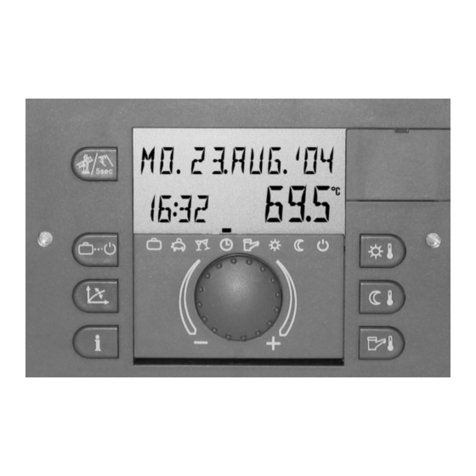
Rotex
Rotex Controller Series Product documentation
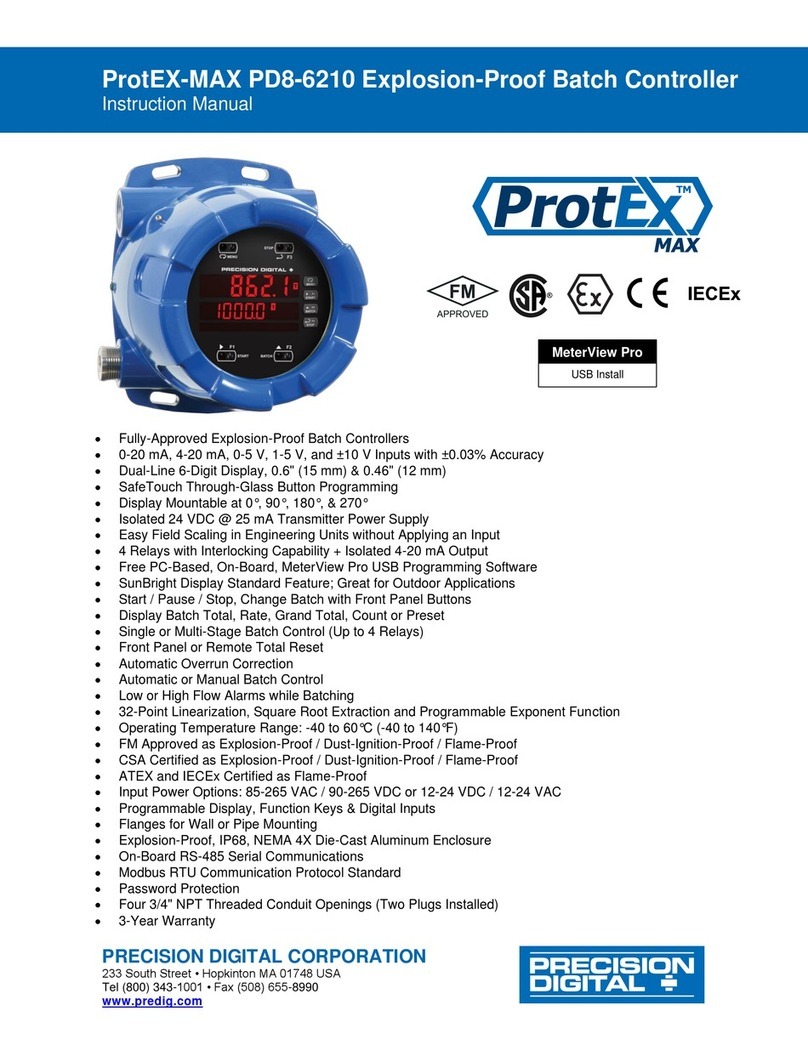
Precision Digital Corporation
Precision Digital Corporation ProtEX-MAX PD8-6210 instruction manual

Westinghouse
Westinghouse IWB-PC02 user manual
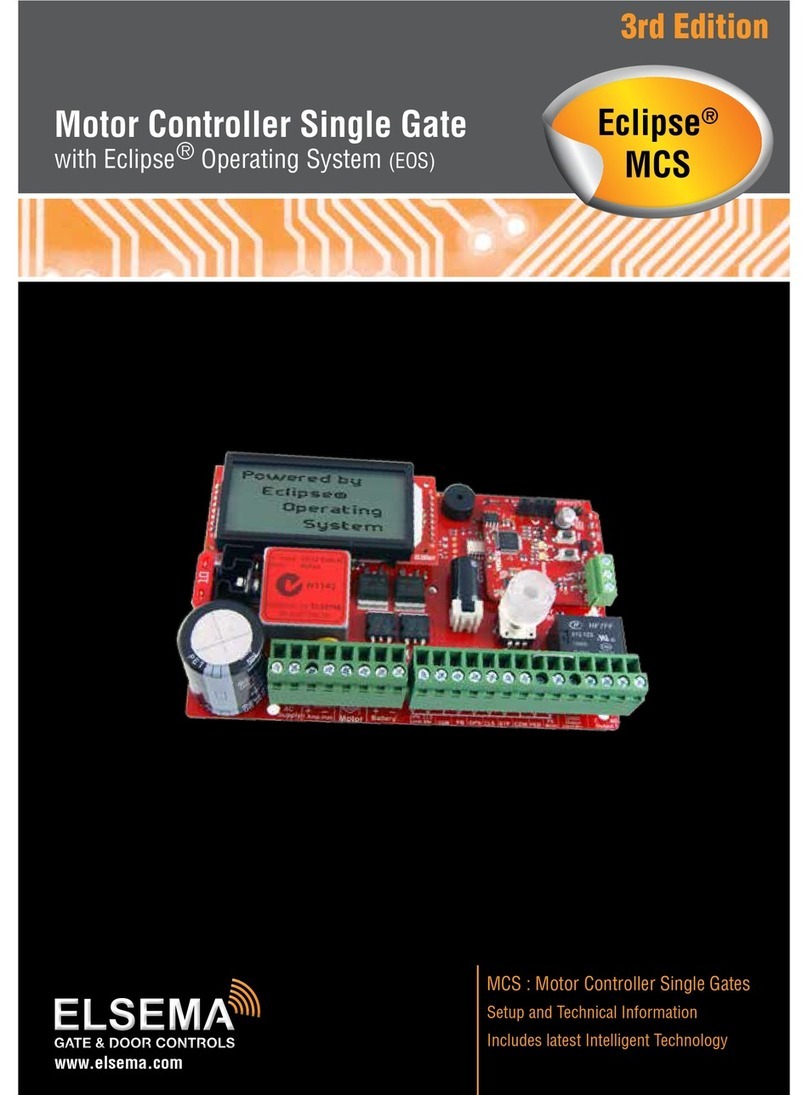
Elsema
Elsema Eclipse MCS Setup manual
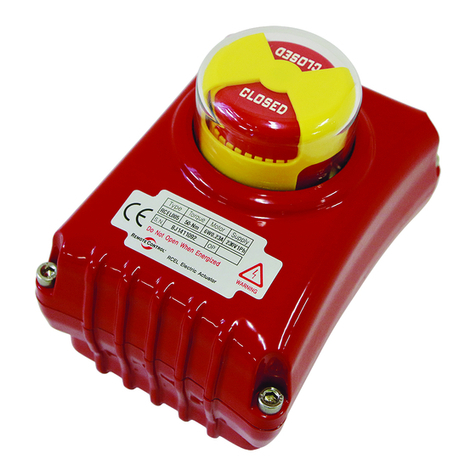
Remote Control
Remote Control RCEL005X instructions
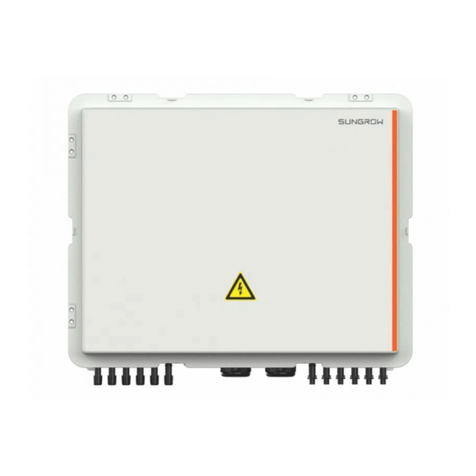
Sungrow
Sungrow PVS-24MH user manual
